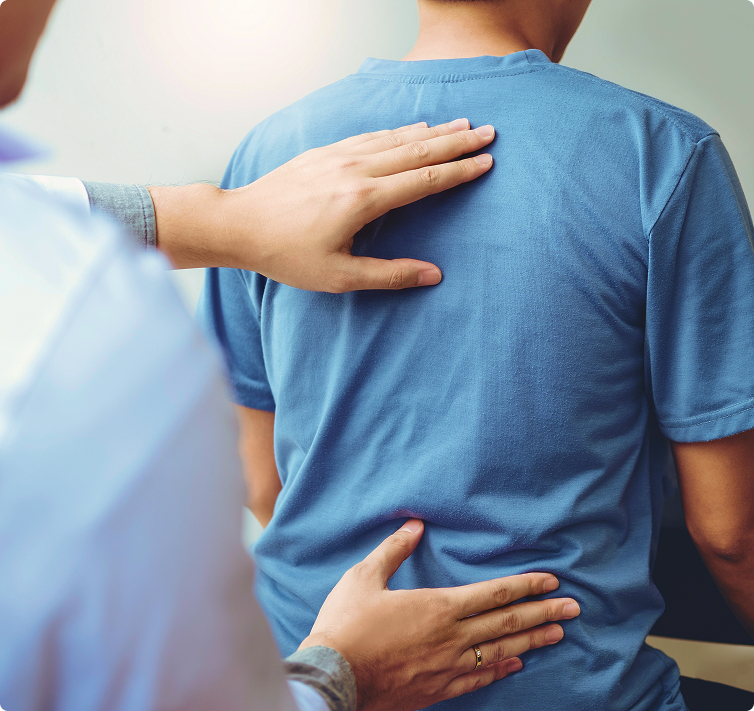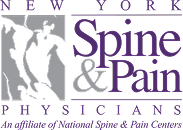Back Pain
Pain Due to Arthritis, Trauma, or Degeneration That Affects the Spine and Surrounding Tissues
The spine is a vital structure that supports the body while providing enough flexibility for movement. The spine is divided into the neck (cervical area), middle back (thoracic area), and lower back (lumbar area). Areas that sustain a lot of twisting and bending, such as the lower back, are most likely to get injured. It is estimated that 80% of the population will have lower back pain, or lumbago, in their lifetime.
80% of adults will experience back pain in their lifetime. Take the FREE back pain risk assessment to understand your risk factors, and aid in preventing complications in the future.
While some back pain episodes improve with rest, anti-inflammatories and other conservative treatments, back pain can become severe and chronic. A pain specialist can treat this type of pain with minimally invasive procedures that calm the pain and allow you to strengthen and recondition.
Facts and Information About Back Pain
Most cases back pain can be traced to one of the following issues:
- Muscle or ligament strain. Heavy lifting or sudden awkward movements may tear muscles and ligaments, causing flareups or long-lasting issues like Myofascial Pain Syndrome (MPS).
- Aging of the discs. The discs normally cushion the back bones and absorb shocks during movement. Aged discs can tear, leading to Degenerative Disc Disease (DDD), a painful neck and back condition.
- Bulging or ruptured disks. Due to aging or trauma, the soft gel material inside a disk can bulge or rupture and start to irritate or press on a spinal nerve.
- Worn joints. The small facet joints of the spine tend to wear down with age, trauma, or arthritis. This leads to Facet Joint Syndrome, a condition that causes back pain, stiffness, and muscle spasms.
- Pinched nerves. Herniated disks or bone spurs can press on a spinal nerve and disrupt its function (Radiculopathy), causing back pain and leg tingling, numbness, or weakness.
- Narrowing of the spinal canal. Degenerated (aged) spinal discs and bone spurs lead to a painful narrowing of the spinal canal, or Spinal Stenosis.
- Spinal fracture. A Spinal Compression Fracture is a break in one of the back bones. Commonly linked to osteoporosis, these fractures are a common cause of lower back pain in females.
- Slippage and misalignment of the vertebrae. Degenerated discs and bone spurs cause the back bones to slip forward, triggering lower back pain and Sciatica.
- Sacroiliac (SI) Joint Dysfunction. Wear-and tear or arthritis of the large SI joint that links the upper body to the pelvis, causes back pain and inflammation in the buttocks and thigh.
- Deformity of the spine. A person may be born with an exaggerated curve of the spine that presses on the discs and joints.
- Infection or tumor. Certain infections and tumors can affect the backbones or enter the spinal canal.
- Trauma. Sudden fractures or spinal dislocations may cause back pain.
Symptoms Linked to Back Problems
Back pain may be episodic, where a person flares up and recovers, or it may become chronic and last several weeks or months. It usually worsens with bending, twisting, lifting, standing or walking. Sometimes, as with rheumatoid arthritis, movement improves the stiffness while excessive rest worsens the pain.
Common findings in people with back problems:

-
1Get Started!Find a Doctor or Location that’s best for you! Find a Doctor
-
2Schedule an Appointment
-
3Prepare for AppointmentComplete the pre-appointment paperwork before your visit.
-
4See You at Your Appointment!We appreciate your trust and look forward to building a care plan for you.
Treating Back Pain
Most episodes of back pain will improve with conservative treatments like rest, ice/heat, massage, and physical therapy. Lower back exercises and stretches can help, while excessive bed rest can prolong the pain.
Consider seeing a pain specialist if the pain:
- Does not respond to over-the-counter medications
- Gets worse
- Accompanies a loss of bowel/bladder control
- Includes leg weakness
-
Pioneering Pain
SolutionsOur doctors don't just use advanced treatments—they pioneer them. -
Quality-Assured
CareComprehensive quality protocols ensure consistent, exceptional care. -
Learning &
LeadingContinuous training and education keep us at the forefront of pain management. -
A Mission
of ReliefYour freedom from pain isn't just our goal—it's our reason for being.

